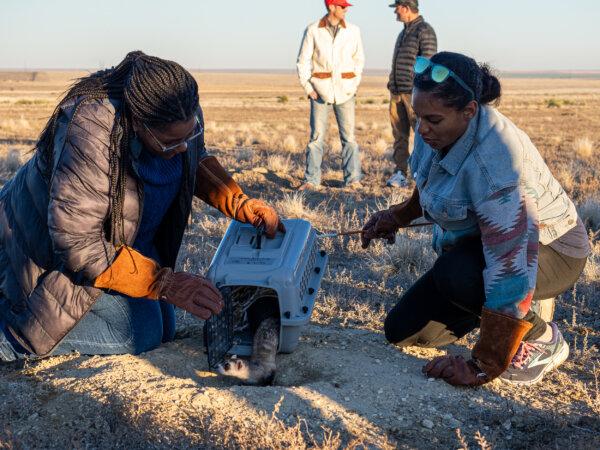Endangered Black-Footed Ferrets Released onto Colorado Prairie by Wildlife Preservation Officials
Once thought to be extinct, the black-footed ferret has recovered around prairie dog populations.
Colorado wildlife officials continue an effort to reintroduce “one of the most endangered mammals in North America” into the wild prairie landscape.
On Nov. 14, the Colorado Parks and Wildlife (CPW) orchestrated the release of three adult black-footed ferrets and 14 kits, or young ferrets, at cattle rancher Dallas May’s private 20,000-acre May Ranch outside Lamar, Colorado, with the help of Lamar Middle School students, CPW Public Information Officer Travis Duncan told The Epoch Times.
According to the U.S. Fish & Wildlife Service (FWS), the black-footed ferret is a medium-sized carnivorous mammal that includes badgers, weasels, otters, and minks.
It’s the only species native to America, with its earliest fossil record dating back 100,000 years. They were first identified in 1851, FWS said, when there may have been up to 1 million ferrets before their population was reduced by “landscape alterations from agricultural expansion and prairie dog eradication.”
A colony of 120 was located and closely monitored, she said. Sixteen were captured when the colony began to collapse. Wildlife officials saved seven of the ferrets—called “The Magnificent Seven”—to breed.
“Every ferret we have right now is descended from seven of those individuals,” she said.

Students from Lamar Middle School gathered at May Ranch for a black-footed ferret release in Lamar, Colo., on Nov. 14, 2024. Courtesy of Colorado Parks & Wildlife
The genetics of the bred ferrets are examined to determine whether they should remain in the captive program or be released into the wild.
If they have what it takes to engage in nature’s dance, they are sent to FWS’s National Black-Footed Ferret Conservation Center in Carr, Colorado, where they are kept in “preconditioning pens” that simulate the wilderness they will encounter.
The diet of the black-footed ferret is 90 percent prairie dog. The ferrets live in prairie dog burrows. For release programs, this means 1,500 acres of eastern Colorado land is required for them to “have a successful viable population.”
Because the ferrets are nocturnal, they are released closer to the evening near active prairie dog burrows where workers open the carrier and wait for them to muster the courage to exit.
“These are predators so they can be a bit—snippy, so we don’t reach in and grab them,” she said. “We let them walk out on their own.”

CPW staff and commissioners gathered at May Ranch for a black-footed ferret release in Lamar, Colo., on Nov. 14, 2024. Courtesy of Colorado Parks & Wildlife
Since 2013, the CPW has released more than 500 black-footed ferrets at eight different sites in eastern Colorado.
Efforts on the May Ranch began in 2021 when the CPW began mapping the area to see if it had enough acres.
CPW Terrestrial Biologist Jonathan Reitz told Duncan that government partnerships with private landowners to restore wildlife populations “are critical to the success of CPW’s recovery efforts.”
“So that really means if we’re going to do something sustainable for ferrets, we need projects on private lands,” Reitz said. “To have a landowner like Dallas May and his family recognize black-tailed prairie dogs are and should be a natural part of the ecosystem, that’s a very rare situation.”
May said he’s committed to protecting wildlife habitat and preserving biodiversity because since he was young, he’s witnessed development destroy natural landscapes.
“Our ranch may only be 20,000 acres, but it’s home to many species,” May said. “We wanted to create a permanent habitat for them, including black-footed ferrets.”

Students from Lamar Middle School gathered at May Ranch for a black-footed ferret release in Lamar, Colo., on Nov. 14, 2024. Courtesy of Colorado Parks & Wildlife





